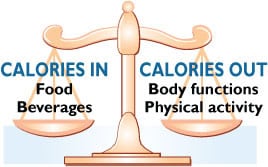Overall there are a variety of factors that play a role in obesity. This makes it a complex health issue to address. This section will address how behavior, environment, and genetic factors may have an effect in causing people to be overweight and obese.
The Caloric Balance Equation
- Overweight and obesity result from an energy imbalance. This involves eating too many calories and not getting enough physical activity.
- Body weight is the result of genes, metabolism, behavior, environment, culture, and socioeconomic status.
- Behavior and environment play a large role causing people to be overweight and obese. These are the greatest areas for prevention and treatment actions.
- A calorie is defined as a unit of energy supplied by food. A calorie is a calorie regardless of its source. Whether you're eating carbohydrates, fats, sugars, or proteins, all of them contain calories.
- Caloric balance is like a scale. To remain in balance and maintain your body weight, the calories consumed (from foods) must be balanced by the calories used (in normal body functions, daily activities, and exercise).

| If you are… | Your caloric balance status is …. |
|---|---|
| Maintaining your weight | "in balance." You are eating roughly the same number of calories that your body is using. Your weight will remain stable. |
| Gaining weight | "in caloric excess." You are eating more calories than your body is using. You will store these extra calories as fat and you'll gain weight. |
| Losing weight | "in caloric deficit." You are eating fewer calories than you are using. Your body is pulling from its fat storage cells for energy, so your weight is decreasing. |
For more, see Healthy Weight – Balancing Calories.
Environment
People may make decisions based on their environment or community. For example, a person may choose not to walk to the store or to work because of a lack of sidewalks. Communities, homes, and workplaces can all influence people's health decisions. Because of this influence, it is important to create environments in these locations that make it easier to engage in physical activity and to eat a healthy diet. The Surgeon General's Call to Action to Prevent and Decrease Overweight and Obesity 2001 identified action steps for several locations that may help prevent and decrease obesity and overweight. The following table provides some examples of these steps.| Location | Steps to Help Prevent and Decrease Overweight and Obesity |
|---|---|
| Home |
|
| Schools |
|
| Work |
|
| Community |
|
Genetics
How do genes affect obesity?Science shows that genetics plays a role in obesity. Genes can directly cause obesity in disorders such as Bardet-Biedl syndrome and Prader-Willi syndrome.
However genes do not always predict future health. Genes and behavior may both be needed for a person to be overweight. In some cases multiple genes may increase one's susceptibility for obesity and require outside factors; such as abundant food supply or little physical activity.
No comments:
Post a Comment